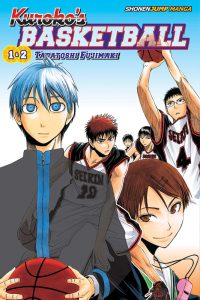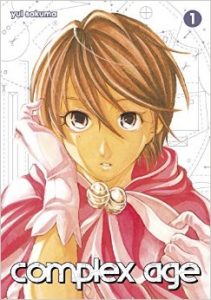By Hico Yamanaka | Published by Kodansha Comics
 Seventeen-year-old Atsuko is desperate for cash. Her father is an ungrateful drunk, they’re so poor that she’s mocked by classmates for her lack of personal hygiene, and she has resorted to fleecing perverted old men just so she can eat. Shortly after a chance meeting in which she runs into her male doppelganger, Itaru, she is kidnapped by his rich friend, Ryo Sekiuchi, and hired to impersonate Itaru (who has gone missing) for one million yen. Atsuko agrees and tutoring commences. She meets some nice people who are concerned for her welfare and appreciative of her effort, which is something she hasn’t experienced before, and learns that happiness isn’t automatic, even if you live in a huge, beautiful mansion.
Seventeen-year-old Atsuko is desperate for cash. Her father is an ungrateful drunk, they’re so poor that she’s mocked by classmates for her lack of personal hygiene, and she has resorted to fleecing perverted old men just so she can eat. Shortly after a chance meeting in which she runs into her male doppelganger, Itaru, she is kidnapped by his rich friend, Ryo Sekiuchi, and hired to impersonate Itaru (who has gone missing) for one million yen. Atsuko agrees and tutoring commences. She meets some nice people who are concerned for her welfare and appreciative of her effort, which is something she hasn’t experienced before, and learns that happiness isn’t automatic, even if you live in a huge, beautiful mansion.
I’m on the fence with how I feel about this volume. It’s not nearly as insightful as it could be, and so far the focus is more on Atsuko’s circumstances (first crappy, then unfamiliar) than on Atsuko herself. Her insta-love—after opening the manga by declaring that the greatest misfortune in the world is to fall in love— for Itaru’s friend Nobunari is also completely sudden and unconvincing. A more nuanced interpretation would suggest that Atsuko is so starved for affection that she’ll latch on to any form of kindness, but I have doubts that the mangaka is thinking that deeply about it at all.
That said, there were some things I liked about it. Ryo’s backstory, for example, and his reasons for wanting to protect Itaru from future repercussions from his controlling family. I also like that Itaru may have run off because he is gender nonconforming and that Nobunari seems to be in love with him. It’s probably not good to be more interested in the person who’s off-screen than the actual protagonist, but at least that’s something. Another point in the series’ favor is that it is short. I reckon I like it well enough to see it through to the end.
The Prince in His Dark Days is complete in four volumes. Kodansha will release volume two later this month.

 In the immortal words of Sir Paul McCartney:
In the immortal words of Sir Paul McCartney: On the one hand, it’s exciting to be reading something new by Natsuki Takaya, creator of my beloved Fruits Basket. On the other, it was kind of weird to embark upon an unfamiliar story whose artistic style was so very familiar to me.
On the one hand, it’s exciting to be reading something new by Natsuki Takaya, creator of my beloved Fruits Basket. On the other, it was kind of weird to embark upon an unfamiliar story whose artistic style was so very familiar to me.
 In the kingdom of Kohka, kindly King Il adores his only child, Princess Yona, and throws a celebration for her sixteenth birthday. Red-haired Yona is primarily preoccupied with getting her cousin, Su-Won, to see her as a woman. After the festivities, she decides to go tell her father that she simply must be allowed to marry Su-Won, only to walk in on her beloved running her father through with a sword. The palace guards are in on the treachery, and ready to comply with Su-Won’s order to dispatch the witness, but Yona is saved by her trusty personal guard, Hak, and the two of them manage to escape.
In the kingdom of Kohka, kindly King Il adores his only child, Princess Yona, and throws a celebration for her sixteenth birthday. Red-haired Yona is primarily preoccupied with getting her cousin, Su-Won, to see her as a woman. After the festivities, she decides to go tell her father that she simply must be allowed to marry Su-Won, only to walk in on her beloved running her father through with a sword. The palace guards are in on the treachery, and ready to comply with Su-Won’s order to dispatch the witness, but Yona is saved by her trusty personal guard, Hak, and the two of them manage to escape. I’m interested in a couple of the villainous characters, too! Kang Tae-jun of the fire tribe has desired Yona for a long time, so his remorse at her apparent death is genuine, even if he’s an entitled jerk. He reminds me of Skip Beat!’s Sho, a little bit, and I have a strong desire to see him switch sides someday and become a better person. And then there’s Su-Won, who ends the volume believing that Yona’s dead and being crowned king even as he admits that he crushed his dearest friends underfoot to achieve it. That’s much more interesting than him being utterly evil, and I wonder if he was manipulated into believing King Il had murdered his father or if that’s actually true. Unfortunately, both of these guys are more interesting to me right now than Hak is. Hopefully that will change.
I’m interested in a couple of the villainous characters, too! Kang Tae-jun of the fire tribe has desired Yona for a long time, so his remorse at her apparent death is genuine, even if he’s an entitled jerk. He reminds me of Skip Beat!’s Sho, a little bit, and I have a strong desire to see him switch sides someday and become a better person. And then there’s Su-Won, who ends the volume believing that Yona’s dead and being crowned king even as he admits that he crushed his dearest friends underfoot to achieve it. That’s much more interesting than him being utterly evil, and I wonder if he was manipulated into believing King Il had murdered his father or if that’s actually true. Unfortunately, both of these guys are more interesting to me right now than Hak is. Hopefully that will change.

 I’ve grown a bit wary of josei romances. I’d prefer them not to be smutty, or to derive much of their drama from misunderstandings, or to feature a controlling male lead. Happily, Everyone’s Getting Married avoids all of those things!
I’ve grown a bit wary of josei romances. I’d prefer them not to be smutty, or to derive much of their drama from misunderstandings, or to feature a controlling male lead. Happily, Everyone’s Getting Married avoids all of those things! I wasn’t sure I was going to like Nichijou.
I wasn’t sure I was going to like Nichijou.  While I can’t say that any of the gags in these two volumes made me laugh, they did make me smile quite often. Rather than the jokes themselves, I think what I like the best was how Arawi-sensei depicted them. He’s got great comic timing, and just the way the panels are laid out makes things funnier. There’s one moment, for example, where Yuuko realizes she has left the homework she actually bothered to do at home, so we get her anguished cry of “Damn it!” depicted from three different angels in the same panel. I also loved it when the “camera” panned to the side to show someone else reacting to what’s happening with the main characters, and there’s also a fantastic nonverbal chapter about building a house of cards.
While I can’t say that any of the gags in these two volumes made me laugh, they did make me smile quite often. Rather than the jokes themselves, I think what I like the best was how Arawi-sensei depicted them. He’s got great comic timing, and just the way the panels are laid out makes things funnier. There’s one moment, for example, where Yuuko realizes she has left the homework she actually bothered to do at home, so we get her anguished cry of “Damn it!” depicted from three different angels in the same panel. I also loved it when the “camera” panned to the side to show someone else reacting to what’s happening with the main characters, and there’s also a fantastic nonverbal chapter about building a house of cards.  The Gods Lie is a seinen one-shot by Kaori Ozaki, who also brought us Immortal Rain, which I liked
The Gods Lie is a seinen one-shot by Kaori Ozaki, who also brought us Immortal Rain, which I liked 


Recent Comments